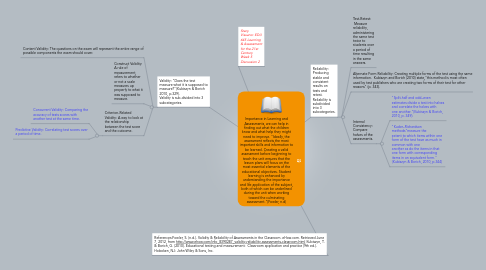Importance in Learning and Assessments, we can help in finding out what the children know and what help they might need to improve. "Ideally, the assessment reflects the most important skills and information to be learned. Creating a valid assessment before beginning to teach the unit ensures that the lesson plans will focus on the most essential elements of the educational objectives. Student learning is enhanced by understanding the importance and life application of the subject, both of which can be underlined during the unit when working toward the culminating assessment."(Fowler, n.d)
by Stacy Visuaño


1. Validity: "Does the test measure what it is supposed to measure?"(Kubiszyn & Borich 2010, p.329). Validity is sub-divided into 3 subcategories.
1.1. Content Validity: The questions on the exam will represent the entire range of possible components the exam should cover.
1.2. Construct Validity: A rule of measurement, refers to whether or not a scale measures up properly to what it was supposed to measure.
1.3. Criterion-Related Validity: A way to look at the relationship between the test score and the outcome.
1.3.1. Concurrent Validity: Comparing the accuracy of tests scores with another test at the same time.
1.3.2. Predictive Validity: Correlating test scores over a period of time.
2. References:Fowler, S. (n.d.). Validity & Reliability of Assessments in the Classroom. eHow.com. Retrieved June 7, 2012, from http://www.ehow.com/info_8390287_validity-reliability-assessments-classroom.html Kubiszyn, T. & Borich, G. (2010). Educational testing and measurement: Classroom application and practice (9th ed.). Hoboken, NJ: John Wiley & Sons, Inc.
3. Stacy Visuano: EDU 645 Learning & Assessment for the 21st Century Week 5 Discussion 2
4. Reliability: Producing stable and consistent results on tests and retest. Reliability is subdivided into 3 subcategories.
4.1. Test-Retest: Measure reliability, administering the same test twice to students over a period of time resulting in the same answers.
4.2. Alternate Form Reliability: Creating multiple forms of the test using the same information. Kubiszyn and Borich (2010) state,"this method is most often used by test publishers who are creating two forms of their test for other reasons" (p. 343).
4.3. Internal Consistency: Compare halves of the assessments.
4.3.1. "Split-half and odd–even estimates divide a test into halves and correlate the halves with one another."(Kubiszyn & Borich, 2010, p. 349).
4.3.2. "Kuder–Richardson methods"measure the extent to which items within one form of the test have as much in common with one another as do the items in that one form with corresponding items in an equivalent form." (Kubiszyn & Borich, 2010, p.344)
